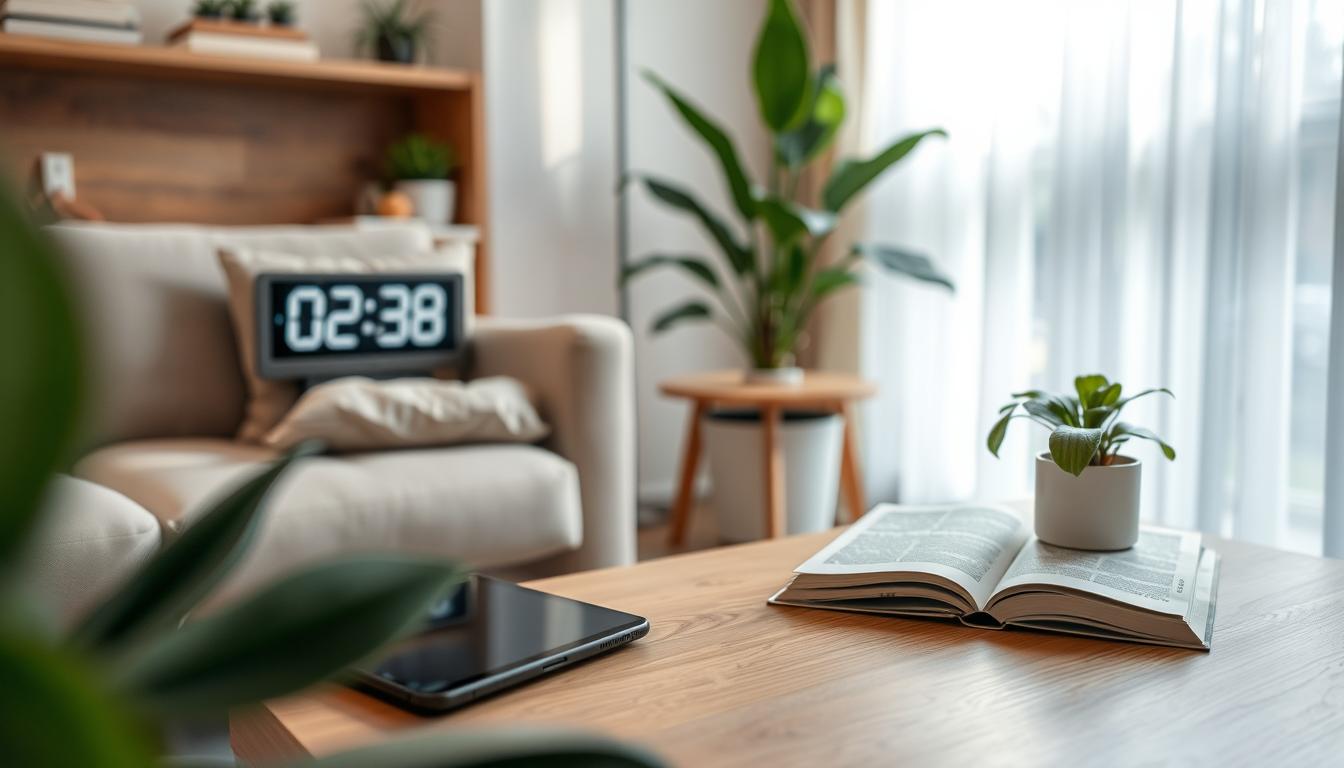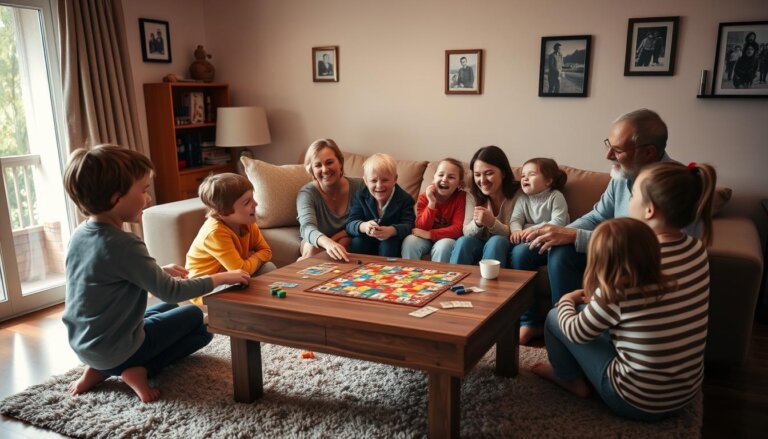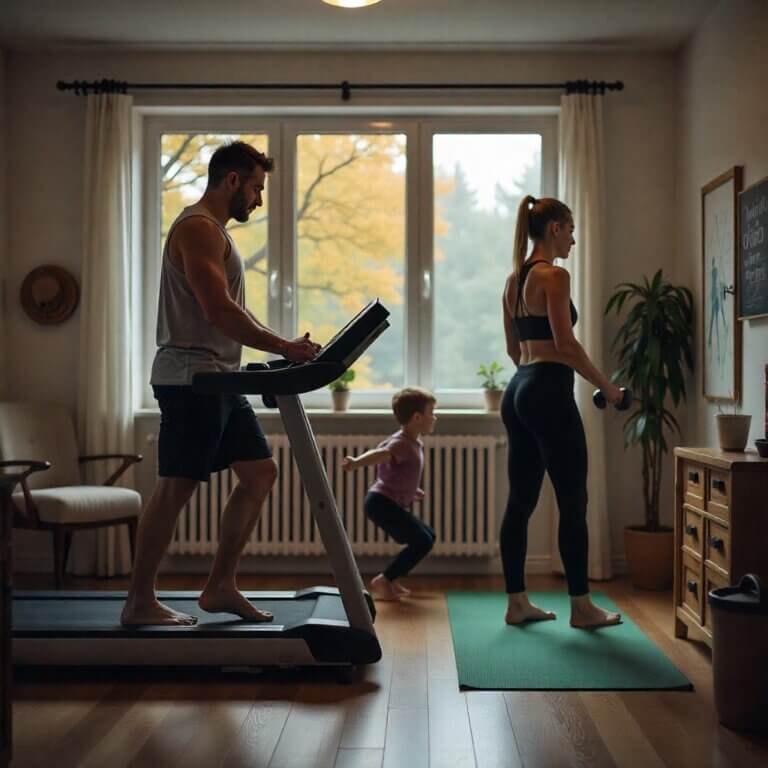Screen Time Limits: A Guide for Digital Wellness
In today’s digital world, finding the right balance is key. We spend a lot of time on screens, making screen time management vital. But, what if you could improve your digital wellness and have a better tech relationship? Explore our guide on screen time limits and find digital harmony.
Our lives are now deeply connected to digital devices. It’s important to know how screen time affects our health. To balance tech benefits and well-being, we need healthy screen time limits and a mindful digital approach.
Understanding Digital Wellness in the Modern Age
In today’s world, digital wellness is key to our health. Technology affects our lives in many ways. It shapes how we work, talk, and have fun. It’s important to have good digital habits for our health.
The Impact of Technology on Daily Life
Digital devices are everywhere, changing how we live. Too much screen time effects can hurt our work, sleep, and relationships. Knowing how tech impacts us helps us stay balanced and healthy.
Defining Healthy Digital Habits
- Establishing mindful technology usage habits
- Cultivating a healthy relationship with digital devices
- Prioritizing offline activities and face-to-face interactions
- Recognizing and addressing tech addiction patterns
- Promoting digital wellness practices for overall well-being
Good digital habits help us avoid screen time effects. They lead to a better, more fulfilling life in today’s world.
“The key to digital wellness is finding a harmonious balance between technology and our daily lives.”
Screen Time Limits: Essential Guidelines for All Ages
In today’s world, it’s vital to have a healthy digital life. Setting the right amount of screen time is key to staying well in the digital world. The American Academy of Pediatrics and the World Health Organization have given us guidelines to manage screen time.
For toddlers and young children, it’s best to limit screen time to one hour a day. This should be high-quality, educational content. It’s important to make sure they also play, move around, and interact with others during this important time.
- School-aged kids should not spend more than two hours a day on screens. They need time for other activities too.
- Teenagers might need a bit more flexibility. Still, experts say they should not spend more than three to four hours a day on screens. They should also have breaks and tech-free areas.
- For adults, the recommended screen time is two to three hours a day. This can change based on personal needs and work.
Remember, these screen time recommendations are just guidelines. Everyone’s needs are different. Things like sleep, thinking skills, and mental health should be considered when setting screen time limits.
“Establishing a healthy balance between digital and offline activities is essential for overall well-being in the modern age.”
Following these screen time limits and using digital usage guidelines helps everyone. It leads to a more balanced life. This balance is good for our bodies, minds, and spirits in today’s digital world.
The Science Behind Digital Device Usage and Mental Health
Our digital world is always changing. Researchers are studying how screen time affects our mental health. They look at blue light exposure and how it impacts our brains.
Effects on Sleep Patterns
Too much screen time can mess up our sleep. Digital devices give off blue light, which stops our bodies from making melatonin. This hormone helps us sleep.
This can make it hard to fall asleep and reduce sleep quality. It also leads to feeling tired during the day. All these issues can cause stress and affect our mental health.
Impact on Cognitive Function
Too much screen time can hurt how well we think. It can make it harder to focus, remember things, and solve problems. The constant digital noise can overwhelm our brains.
This can make us less productive and lower our cognitive abilities. It’s important to find a balance between digital and real-world activities.
Psychological Well-being Factors
- Social isolation and loneliness: Spending too much time on digital devices can make us feel disconnected. This can lead to depression and anxiety.
- Digital eye strain: Looking at screens for too long can cause eye problems. This can make us feel stressed and tired.
- Tech-induced stress: The constant alerts and pressure to respond quickly can increase stress. This can harm our mental health.
As research continues, it’s clear we need to balance digital and real-world activities. This is key for our mental health in today’s world.
Setting Up Effective Screen Time Boundaries
In today’s digital world, setting clear digital boundaries is key for a healthy tech-life balance. By setting screen time rules and device usage limits, you can control your tech use. This helps you live a more balanced life.
Begin by looking at your digital habits. Track how much time you spend on screens each day. Find out where you might be spending too much time. This self-check will help you make a plan to use devices less.
- Set realistic goals: Decide on screen time limits that fit your life. Slowly cut down your device usage to find a good tech-life balance.
- Implement scheduled breaks: Make sure to have screen-free times, like during meals or before bed. This keeps your digital boundary healthy and stops too much device usage.
- Use technology to help you: Use digital wellness tools and parental control solutions to track and limit your screen time. These tools offer insights and help you stick to your screen time rules.
Being consistent and disciplined is crucial for good digital boundaries. Stick to your screen time limits and adjust as needed for a healthy tech-life balance. Remember, finding the right balance with technology and well-being is a journey. But the rewards are worth it.
“The first step towards getting somewhere is to decide that you are not going to stay where you are.” – J.P. Morgan
Digital Wellness Tools and Applications
In today’s world, it’s important to manage screen time and find a healthy balance with technology. Luckily, many digital wellness tools and apps are here to help. They let users track their screen time, set limits, and stay focused without distractions.
Screen Time Tracking Apps
Apps like Screen Time (for iOS) and Digital Wellbeing (for Android) give users a clear view of their device use. They show how much time is spent on apps, browsing the web, and overall screen time. This helps users understand and change their digital habits.
Parental Control Solutions
For parents, tools like Family Link (Google) and Restrictions (Apple) are very useful. They let parents control their kids’ screen time and what they see online. Parents can set limits, block certain content, and keep an eye on device use. This makes the digital world safer and more balanced for kids.
Focus Enhancement Tools
- Apps like Forest and Focus Keeper help users stay focused. They grow virtual trees or complete work intervals without using devices.
- Freedom and AppBlock block distracting websites and apps. This helps users avoid digital distractions and stay focused.
Using these digital wellness tools and apps, people and families can better manage their screen time. They can set limits and find a healthier balance with technology. This leads to better well-being in our digital world.
Creating a Balanced Digital Lifestyle
In today’s world, finding the right balance between digital and offline activities is key for our well-being. Digital minimalism helps us take back control of our digital lives. It leads to a more harmonious tech-life harmony.
Regular digital decluttering is a big part of achieving balance. It means getting rid of digital distractions that waste our time and attention. By cleaning up our digital spaces, we make room for hobbies, friends, and rest.
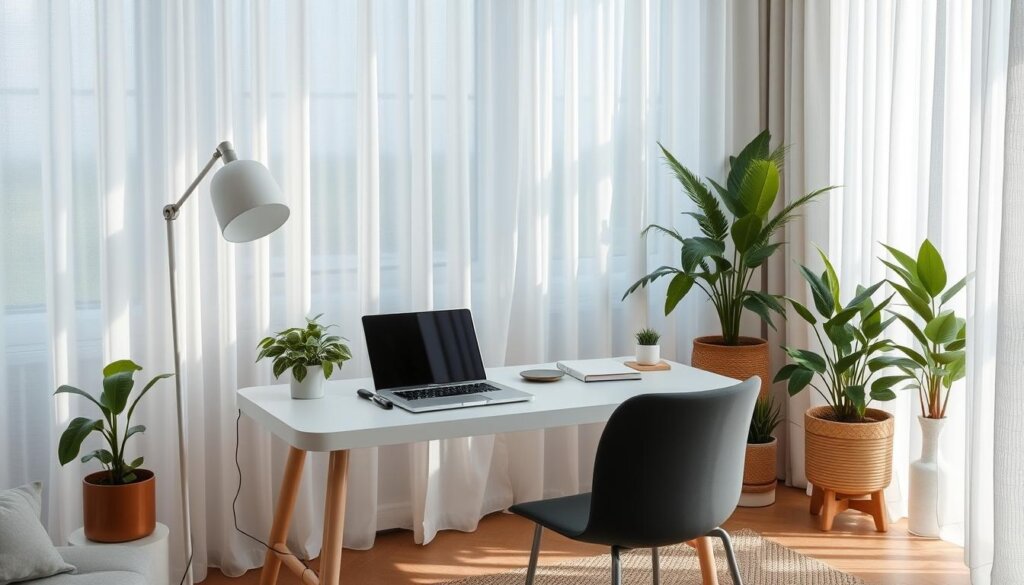
Along with decluttering, we need to use technology mindfully. This means being careful about when and how we use our devices. We should set limits and enjoy offline activities that are good for us. Reading, walking, or doing creative things can help us feel refreshed and balanced.
“The ability to focus attention is a superpower.” – Cal Newport, author of “Digital Minimalism”
By following digital minimalism and tech-life harmony, we can improve our lives. We can get our time, energy, and focus back. A better relationship with technology is possible, and it can greatly improve our lives.
Implementing Screen-Free Zones and Times
In today’s digital world, it’s key to have device-free zones and tech-free time. This helps us build strong relationships and bond as a family. By setting aside areas and times for offline activities, we find balance and mindfulness in our lives.
Designating Tech-Free Spaces
Begin by picking spots in your home for device-free zones. Think about the dining room, a family room, or a cozy corner. These places should be free from screens, encouraging everyone to be present and connect.
Family Time Without Screens
Make time each day or week for tech-free time with your family. Try it during meals, before bed, or on a “family night.” Activities like board games, reading, or walks are great. These device-free times help you bond and grow closer.
“Unplugging from technology and reconnecting with loved ones is one of the best ways to achieve digital wellness and maintain a healthy balance in our lives.”
Starting screen-free zones and tech-free times might take some getting used to. But the rewards are huge. These moments help us connect deeper, reduce stress, and live a more balanced life together.
Managing Professional Screen Time in Remote Work
Remote work is becoming more common. Managing screen time is now a big challenge. It’s key to keep a balance between work and life and to work ergonomically.
Setting clear boundaries between work and personal time is crucial. Take regular breaks from screens to prevent eye strain and headaches. Use digital wellness tools to track and limit your screen time.
Creating a comfortable workspace is also vital. Invest in a good chair, adjustable desk, and proper lighting. Good posture and stretching can also help during long screen times.
“The key to remote work productivity is finding a healthy balance between work and life. Regular screen breaks and a thoughtfully designed workspace are essential for maintaining both work-life balance and remote work productivity.”
By focusing on managing screen time and ergonomics, remote workers can create a healthy work space. This leads to better focus, less stress, and overall well-being.
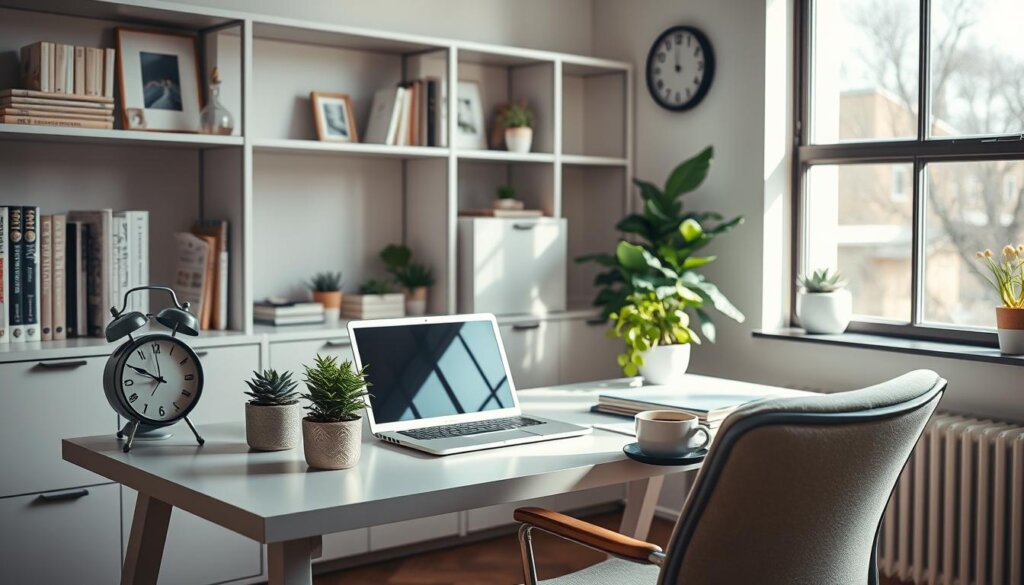
Digital Detox Strategies and Benefits
In today’s world, it’s key to find ways to disconnect and recharge. A digital detox can greatly improve your mental health, relationships, and overall well-being. By using tech detox plans, you can cut down on screen time and live a more balanced digital life.
Short-Term Detox Plans
For those new to digital detox, start with a short-term plan. Try a weekend or week without your devices to focus on screen-free activities. Some good short-term strategies include:
- Turning off all digital devices for 24 hours or a weekend
- Limiting social media and online time to a few hours a day
- Going on a “tech-free” family outing or vacation
Long-Term Lifestyle Changes
For lasting benefits, make long-term digital detox a part of your daily life. This means slowly cutting down on screen time, making tech-free zones at home, and building healthier tech habits. Examples of long-term changes include:
- Setting times of the day or week as “unplugged” periods
- Doing regular outdoor activities or hobbies that don’t need devices
- Starting a bedtime routine that doesn’t include screens
The unplugging benefits of a digital detox are huge. You can see better focus, productivity, mental health, and stronger social bonds. By taking on screen-free challenges and tech detox strategies, you can take back your time, lower stress, and live a more balanced digital life.
“The ability to be in the present moment is a major component of mental wellness.” – Eckhart Tolle
Building Healthy Digital Habits for Children
As parents today, it’s key to teach kids about healthy screen time. Creating a family media plan and being involved in digital parenting helps kids learn to use tech wisely. This way, kids can enjoy technology while keeping a balanced life.
Setting screen time limits is important. Experts say kids should not spend more than 2 hours a day on screens. It’s also vital for parents to show good tech habits themselves, like taking breaks from screens to spend time together.
- Make a family media plan that sets rules for device use, online safety, and tech-free areas.
- Support educational tech use, like learning apps and websites, to improve tech skills.
- Let kids help decide their digital habits, giving them a say in their tech use.
“Raising children in the digital age requires a delicate balance of embracing technology’s benefits while instilling responsible tech habits.”
By using these methods, parents can help kids have a good relationship with technology. This prepares them for a future where knowing how to use digital tools is important. With steady guidance and good examples, kids can confidently use technology in a balanced way.
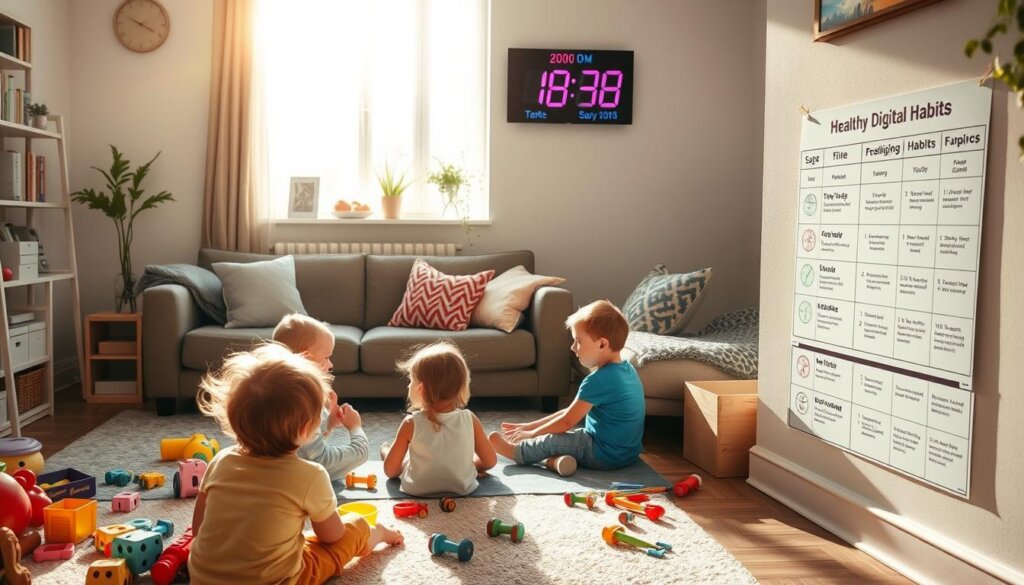
Conclusion
Achieving digital wellness is a journey that never ends. It’s about finding the right balance between technology’s benefits and our health. We’ve looked at how to set screen time limits and create healthy tech habits for everyone.
Remember, there’s no single way to achieve digital wellness. Each person’s journey is unique, based on their needs and lifestyle. The goal is to stay mindful and keep trying to find the perfect balance for you.
The journey to tech-life harmony is about learning and growing. By setting boundaries and using digital wellness tools, you can improve your life. Stay committed to your well-being, and you’ll enjoy a better relationship with technology.
FAQ
What is digital wellness, and why is it important?
Digital wellness is about finding a balance with technology in our lives. It’s key because too much screen time can harm our health and relationships.
How can screen time limits help with digital wellness?
Setting screen time limits helps us use technology wisely. It reduces the risk of addiction and improves sleep and focus.
What are the recommended screen time guidelines for different age groups?
Screen time guidelines change with age. Kids under 5 should watch less than an hour of quality shows daily. Older kids and teens should have a daily limit too. Adults should also limit their screen time for better health.
How does excessive screen time impact mental health and cognitive function?
Too much screen time can harm our mental and cognitive health. It can lead to anxiety, depression, and sleep problems. It also makes it hard to focus and remember things.
What are some effective strategies for setting and maintaining screen time boundaries?
To set screen time limits, make a plan and use apps to track it. Make tech-free zones and times. Get your family involved. Stick to it and make small changes for lasting habits.
What are the benefits of a digital detox or tech-free periods?
Digital detoxes improve sleep and reduce stress. They help us focus better and connect more with others. They give us back control over our digital lives.
How can parents help their children develop healthy digital habits?
Parents can set screen time limits and model good tech use. Encourage kids to play outside and make a family media plan together. Talk and teach them about using technology wisely.

